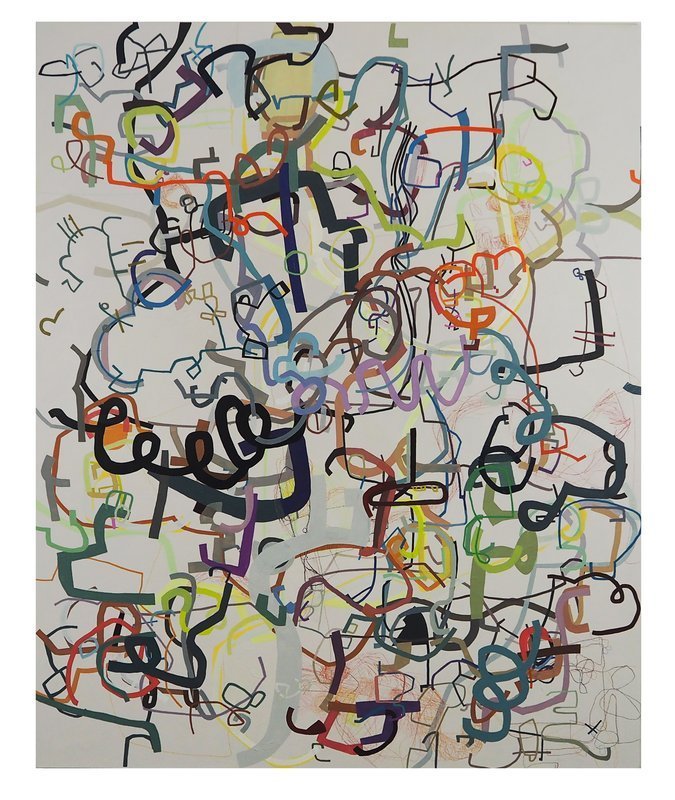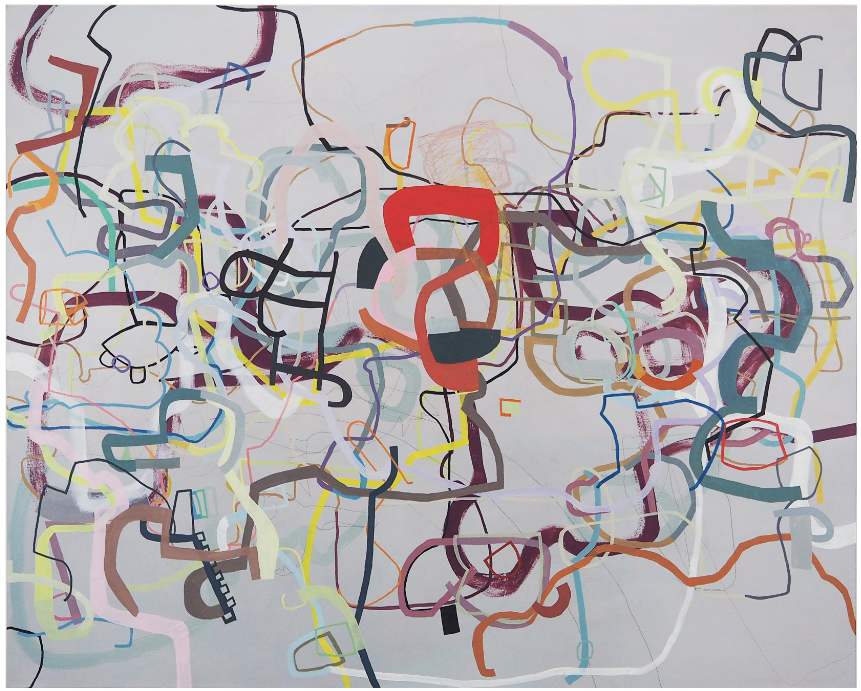The Fun Parent, Father’s Day Exhibition 2024
Sasha Bezzubov • Thomas Broadbent • Phil Buehler • Sean Hemmerle • Stephen Mallon • Mark Masyga
The "Thunderbolt" roller coaster at Coney Island; basketball backboards from around the world; trains and beach parties! Our Father's Day exhibition has it all! Featuring works by six of Front Room's fathers: Sasha Bezzubov, Thomas Broadbent, Phil Buehler, Sean Hemmerle, Stephen Mallon, and Mark Masyga.
Thomas Broadbent
Thomas Broadbent, “An Early Summer” watercolor on paper, 33”x26” more info
Thomas Broadbent, “Note Taking” watercolor on paper, 22”x30” more info
Thomas Broadbent, “The Perch” oil on canvas, 36”x36” more info
Thomas Broadbent’s philosophical compositions often depict animals amongst mundane trappings of everyday humanity. These paintings, in a seemingly well structured world of man-made artifice, reference the underlying impulses of nature. These situations could be looked at as stand-ins for society in an ambiguous relationship with nature that is absurd—and yet peculiarly comfortable. In these contemporary surrealist paintings, Broadbent positions animals amongst high design elements, dislocating them from their native habitats. Broadbent’s paintings often examine the role and existential value that luxury design items have on society. Referencing the materialism and symbolism in Dutch Golden Age Still Life paintings, the artist updates the symbols of wealth and necessity, as considered from a contemporary vantage point. Isolated elements are selected by the artist to extract meaning from the rich history of furniture and interior design trends. Broadbent’s paintings are plausible scenarios, but the unlikely combination of elements, objects, and animals are otherworldly and ubiquitous at the same time, each component carefully selected to heighten its’ meaning.
Stephen Mallon
Stephen Mallon, "Caboose UP 25807" color photograph, edition of 10, 10”x30”, 15”x45”, 20”x60” more info
Stephen Mallon, "IC 977138" color photograph, edition of 10, 10”x30”, 15”x45”, 20”x60” more info
Stephen Mallon, "Boxcar WP 38195" color photograph, edition of 10, 10”x30”, 15”x45”, 20”x60” more info
Stephen Mallon, "Flatcar PTTX 137045" color photograph, edition of 10, 10”x30”, 15”x45”, 20”x60” more info
Stephen Mallon, "Boxcar RBOX 33863" color photograph, edition of 10, 10”x30”, 15”x45”, 20”x60” more info
Stephen Mallon’s series of photographs, “Passing Freight” captures the still active rail lines that carry freight to destinations across the continental United States. Mallon’s industrial landscape photographs isolate singular freight cars within this iconic transportation system, which has played a critical role in supply infrastructure across the continent for hundreds of years. These trains inhabit their environment, as characters that are not visibly moving but seem completely encapsulated with the landscape around them. Within the frame of the photograph the train cars take up almost all of the composition, yet the little hints above and below them place them in a singular space.
Sean Hemmerle
Sean Hemmerle, “HOOPS” Miami, Florida, USA 2005, color photograph, edition of 5, 17”x20.5”, 35”x42” more info
Sean Hemmerle, "HOOPS," Brooklyn, New York, 2005, color photograph, edition of 5, 17”x20.5”, 35”x42” more info
Sean Hemmerle, "HOOPS," Shanghai, China, 2006, color photograph, edition of 5, 17”x20.5”, 35”x42” more info
Sean Hemmerle, "HOOPS," Campa da Pallencestro, Venice, Italy, 2022, color photograph, edition of 5, 17”x20.5”, 35”x42 more info
In the photography series, “HOOPS,” Sean Hemmerle takes a look at the cultural phenomenon and spread of the American sport of basketball to all corners of the globe. Hemmerle’s photographic portraits of basketball courts document sites in over 14 countries in North America, Central America, Asia, Europe and Africa. Hemmerle's project illuminates the universal appeal of basketball, transcending the barriers of language, religion, and geopolitical divides. Hemmerle’s lens captures the essence of a game that speaks a universal language of camaraderie, resilience, and unity, offering a visual narrative that resonates with audiences irrespective of their cultural or linguistic background.
Phillip Buehler
Phillip Buehler, “Steeplechase Park - Coney Island, 1981” color photograph, 18”x24”, 30”x40”, 46”x60” more info
Phillip Buehler, “Registry - Ellis Island, 1974” color photograph, 18”x24”, 30”x40”, 46”x60” more info
Phillip Buehler, “William Tell Statue - Rat Island, 2023” color photograph, 18”x24”, 30”x40”, 46”x60” more info
Phillip Buehler, “Thunderbolt -Coney Island, 1997” color photograph, 18”x24”, 30”x40”, 46”x60” more info
Phillip Buehler, “Tiny Planet, Bannermans” color photograph more info
Phillip Buehler, “Tiny Planet, Boat Graveyard” color photograph more info
Phillip Buehler, “Tiny Planet, Swinburne Island” color photograph more info
Phillip Buehler, “Tiny Planet, Boat Graveyard” color photograph more info
Phillip Buehler is a New York based photographer who documents the deterioration and remnants of neglected architecture constructed in the recent past. In the series “No Man is an Island, Poetry in the Ruins of the New York Archipelago” Buehler has photographed the historic, and also often forgotten islands, around New York City. Buehler’s series traces its birth to his trips in a rowboat to then-abandoned Ellis Island in 1974, when he was seventeen, to make a 16mm documentary film. Some of them, like Ellis Island, loom large in their impact on history, culture and existence in the national identity.
Mark Masyga
Mark Masyga, Butter, with Wrapped Machine (we strive for rambastlin'), 79 x 54", oil and graphite on canvas more info
Mark Masyga, Orange is the New Orange (leave it alone), 60" x 48" oil and graphite on canvas more info
Mark Masyga, I Called Her Yesterday (but her name was Tomorrow), 40”x50” oil, graphite on canvas more info
In Mark Masyga's paintings, partial words, letterforms, and flourishes, such as serifs, intermingle with the linear brushstroke and non-referential forms. The hierarchy of the line-work and layers is conflated with the characters, which are often obscured to the point where they may not even be acknowledged, or recognized only when viewed for a period of time. The overall result is an illusionistic depth of non-deterministic linear contours, shapes, and brushstrokes that have combined to create a new language of interacting glyphs and forms. Selected forms of relative tint and tone nearly fuse with the neutral background to give a feeling of a great distance between those and the more saturated color shapes that rise to the foreground. Opposing colors and their tangency to each other create a simultaneous contrast that distorts the visual perception of depth. The final compositions present myriad points of contemplation where color and line intersect, with the voids between the visual elements being just as active.
Sasha Bezzubov
Sasha Bezzubov, “cave, Mexico” 2013/14 “We are the Kings and Queens of Narnia” sizes: 20"x24, 30"x40", 40"50", edition of 5 more info
Sasha Bezzubov, “beach, Spain” 2022 “We are the Kings and Queens of Narnia” sizes: 20"x24, 30"x40", 40"50", edition of 5 more info
Sasha Bezzubov, “crown, Mexico” 2014/15 “We are the Kings and Queens of Narnia” sizes: 20"x24, 30"x40", 40"50", edition of 5 more info
We are the Kings and Queens of Narnia" is a series of photographs about Sasha Bezzubov's family's somewhat unconventional way of traveling around the world - by walking, which started when his son Niko was born. He just turned 14 and has already hiked a somewhat impressive 1,000 miles. The final project will also include landscapes from their travels. Sasha Bezzubov’s photographic approach has developed through diverse series that address the contemporary condition and explore the nature of the document. Sasha Bezzubov uses a large format camera to photograph the people and the land in diverse series including, The Gringo Project, Expats & Natives, Things Fall Apart, The Searchers, Albedo Zone, Facts on the Ground and Sad Tropics.




























